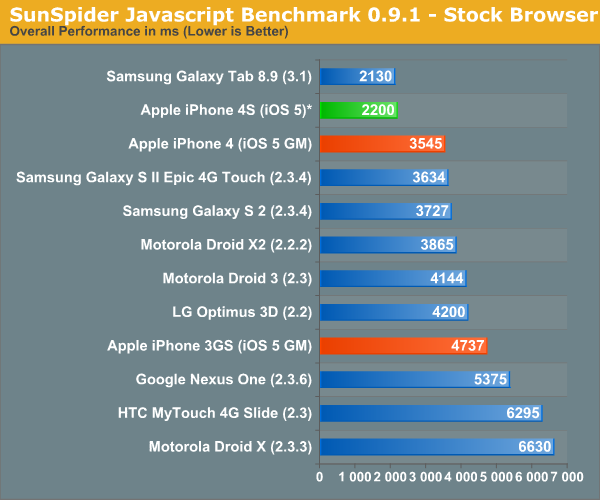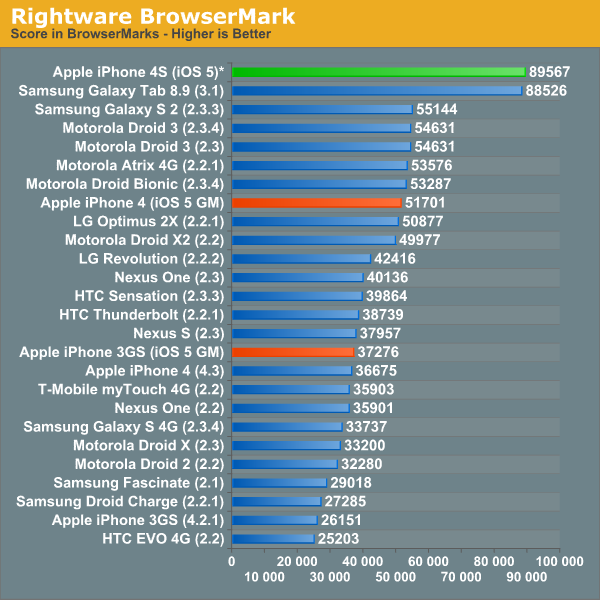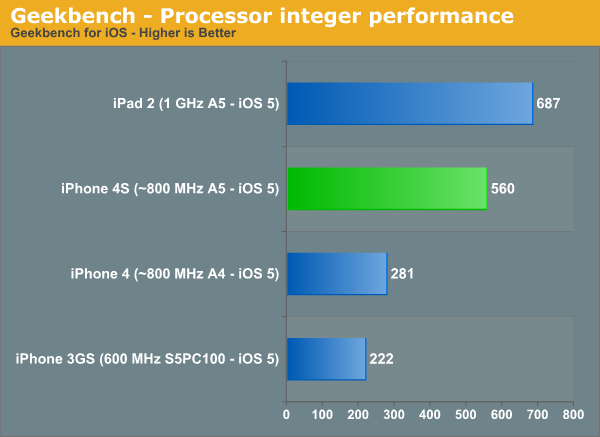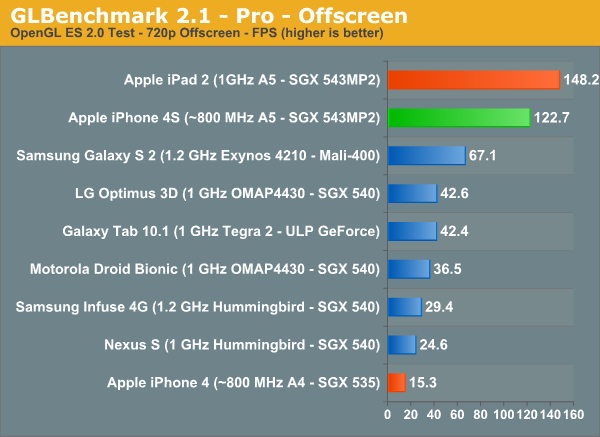iPhone 4S Preliminary Benchmarks: ~800MHz A5, Slightly Slower GPU than iPad 2, Still Very Fast
by Anand Lal Shimpi & Brian Klug on October 11, 2011 3:22 AM EST- Posted in
- Smartphones
- Apple
- Mobile
- iPhone 4S
- SoCs
Apple's ability to control the entire information chain, down to the point of limiting leaks, appears to be gradually slipping as it grows as a company. Case in point are the numerous hardware and performance leaks surrounding the newly launched iPhone 4S. Little did we know that several weeks ago we were staring at photos of the 4S' PCB, and more recently we've seen the first performance results from Apple's first A5 based smartphone thanks to a few eager users around the web. We've compiled these results here from various sources (all linked below) and compared them to our existing database of tests.
The results are pretty much as expected. Javascript performance finally catches up to Tegra 2 based Honeycomb devices, while general CPU performance is significantly higher than the iPhone 4. I suspect Ice Cream Sandwich will bridge the Android smartphone gap (the Honeycomb equipped Gtab 8.9 is here to give you an idea of where a more modern Android browser ends up).
Keep in mind that all of these tests measure performance of the software stack in addition to the hardware. In particular the web browser tests depend largely on browser optimizations, which is why we see differences between similar hardware running different browser versions. Also note that all results were run at stock, with the stock browser. Finally, although these browser tests were captured on video we'll still be running our official tests once our 4Ses arrive and will update accordingly.


Using some of the integer and fp tests of published Geekbench scores we can already conclude that Apple is shipping a lower clocked A5 in the iPhone 4S than it does in the iPad 2. This naturally makes sense as the iPhone 4S has a much smaller 5.25 Whr battery. Based on the Geekbench results it looks like the iPad 2 is clocked around 25% higher than the iPhone 4S, pegging the latter's clock speed at 800MHz.


A lower clock not only means higher yields from the factory, but likely a lower operating voltage as well. Dropping a CPU's core voltage, yields a greater-than-linear decrease in power consumption, making the marginal loss in clock speed a good choice. At a lower operating frequency than its Android competitors, Apple does have to exploit its strengths in software to avoid any tangible performance penalties. Apple has traditionally done this very well in the past, so I don't expect the loss of frequency to be a huge deal to the few who do cross-shop iOS and Android.
Unsurprisingly, memory bandwidth doesn't appear to have gone up either compared to the iPad 2's A5 (taking into account scaling due to CPU clock increases). The Samsung part number on the iPad 2's A5 indicates two LPDDR2-800 die on package, it's safe to assume that whatever Apple clocked the memory interface at in the iPad 2 remains unchanged in the iPhone 4S.
The GPU results tell a similar story courtesy of some early GLBenchmark 2.1 results. The 960 x 640 results are useless as they are bound by vsync at ~60 fps. Luckly GLBenchmark 2.1 added an off-screen render mode at 1280 x 720 where we can really see the differences between the iPad 2 and iPhone 4S A5 implementations:


Here the iPad 2 holds a ~21% performance advantage, which once again I assume to be all related to clock speed. Also note the huge advantage over the existing iPhone 4. The GPU power in the 4S should be more than enough to run any well written, current generation title at well north of 30 fps on its display.
We'll be reviewing the iPhone 4S in the coming weeks, stay tuned!
Source: GLBenchmark Database, Geekbench Database, Macrumors










216 Comments
View All Comments
DeciusStrabo - Tuesday, October 11, 2011 - link
My SGS II results are better than the ones in the table, but not that much - 3500 ms in Sunspider and 60,000 in Browsermark. I'm using RomRevolution 2.7 as Rom, maybe CM7 uses both CPU-cores? That would explain your result.adrien - Tuesday, October 11, 2011 - link
We can still see the performance gains after the iPhone 3GS in sunspider but this one is quite surprising. WebKit is the same shared codebase (after a delay sometimes, but it _has_ _to_ be out now) and it had reached a plateau:http://arewefastyet.com/old-awfy.php
I always find such improvements dubious and I really can't wait to see the full benchmarks and analysis.
Brian Klug - Tuesday, October 11, 2011 - link
Sure, JS performance has plateaued on desktop architectures (that page seems to only apply to x86 and x64), but clearly mobile (ARMv7 w/NEON) is enjoying the benefits of newfound attention. Keep in mind that the JS engine isn't shared between iOS and Android at all: Android uses V8, iOS is using a mobile version of Nitro. I'm told at present that there are fewer than 5 people dedicated full time to ARM V8, and who knows how many for Nitro.The huge improvements in iOS 5 are thanks in part to moving to an updated Safari 5.1 codebase:
"The WebKit framework has been updated to a version which closely matches the engine used by Safari 5.1 on the Desktop. There are some areas to be aware of with the new WebKit framework on iOS 5."
We'll be talking about this more in our iOS 5 review.
-Brian
odedia - Tuesday, October 11, 2011 - link
You go through a battery in 4-5 hours. I think it is either related to iCloud or iTunes WIFI syncing, turning these two off solves the issue.tipoo - Tuesday, October 11, 2011 - link
Probably only a one time thing for battery that bad then. Like a new laptop indexing all the files.jklubi - Tuesday, October 11, 2011 - link
Can you at least include the Nokia N9 and N900to give an overall look,
skydrome1 - Tuesday, October 11, 2011 - link
The GPU's power level...It's over 9000!
What?! IT'S OVER 9000?!
I'm really really really excited about PowerVR's GPUs!!! Even the PS Vita has one of em'. Or maybe 4.
make_dots - Tuesday, October 11, 2011 - link
Why that sunspider and browser chart does have Galaxy Tab but doesn't have iPad 2 nor iPad 1?You guys must put them on the chart for comparisons.
Mike1111 - Tuesday, October 11, 2011 - link
I second that. IF you put tablet results in smartphone benchmarks you should at least have one of each in there, especially if it's the fastest one (iPad 2).BoyBawang - Tuesday, October 11, 2011 - link
I remember that the Die size of Exynos is about the same size as A5 at 45mn process But GPU architecture made a huge gain for A5! Samsung should give up Mali and follow the PowerVR path.